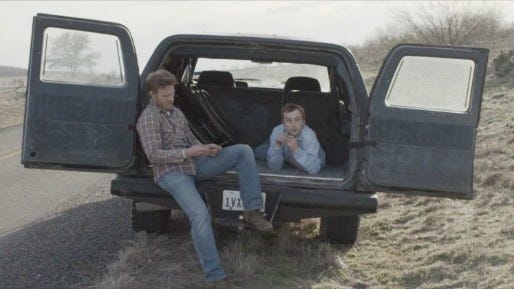This is Where We Live

Many times, films that tackle a subject as serious as cerebral palsy want to show its difficulties, then thrust a tidy happy ending in your face as a resolution. Filmmakers Josh Barrett and Marc Menchaca escape that trap in "This is Where We Live." They have the courage to show each individual's struggles, no matter how ugly, and not promise us a happily ever after.
In "This is Where We Live," Noah (Menchaca) is hired to build a wheelchair ramp for the Sutton family, but after helping Diane (C.K. McFarland) put her disabled son August (Tobias Segal) to bed, he is enlisted to spend time with the younger man.
Following some initial struggles trying to understand August, the two begin to form a bond that reveals August to be a thoughtful, intelligent and compassionate person.
August has other issues going on in his life as well. His sister Lainey (Frankie Shaw) doesn't offer much in the way of help with anything and his father, Bob (Ron Hayden), suffers from dementia. His mother has the best intentions but is ultra-protective of her son and doesn't allow his to wander far from her side.
As Noah and August's bond grows stronger, August begins to experience the life that's been put on hold by his disease. He ventures into town, takes a fast ride in an ATV and shares a beer with his newfound caretaker.
But for all the progress made with August, everyone else's lives seem in slow motion. Everyone seems stuck in place trying to break free from a past that won't let go. Noah struggles with the death of his brother; Lainey struggles with the loss of a child; Diane struggles to keep her family together; and August struggles to have his beautiful voice heard.
Noah and Lainey share a darkness that threatens to consume them and influences their daily lives. Not once in the film does either character reveal the source of their sorrow. The filmmakers opt to cleverly show elements of their past.
The use of flashbacks showing Noah's youth with his brother and how he died are very well done. They unfold as layers, giving us a glimpse of a happy childhood, which ultimately turns into tragedy. In Lainey's case, the reveal is even more subtle. Barrett and Menchaca give us the pieces and relies on us to put them together.
In the end, it is August, the person others look at as being the one needing the most assistance, who helps break everyone free from their demons.
Menchaca pulls triple duty in the film, serving as co-director, screenwriter and one of its principal actors. Except for a drunken scene at the bar, Menchaca is spot on as Noah. He shows us a complex man who wants to be the best he can be, but can't break from the specter of his brother's death.
Shaw is equally impressive as Lainey. The beautiful actress gives us a roller-coaster of emotions and goes from being completely unlikable to a character for whom you hope the best.
The real treat of this film is to watch Segal work his craft as August. Segal doesn't overplay the role — something to which most actors would fall prey. He utters only a few words throughout the movie, but his character is the voice of the story.
One of my favorite parts of the film is when August uses his word board to scold Noah after a lunch trip to town. Noah orders for August, who refuses to eat what is put before him. Once home, Lainey helps August use the board, who tells Noah to ask him, don't tell him, what he wants.
Without only a few words, Segal shows August to be a strong, independent young man. Segal is by no means a newcomer to the business, but I think if he can keep providing strong performances such as that in "This is Where We Live" he could easily start popping up on people's radar.
"This is Where We Live" is a quiet film featuring a top-notch performance by Segal. The film screams authenticity as we're brought into the struggles of the Sutton family's everyday life. "This is Where We Live" is what independent film is all about. A great story, featuring great acting, presented in an interesting way.
4 Yaps


